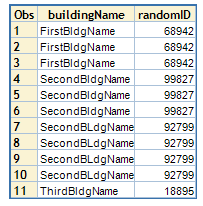- Home
- /
- Programming
- /
- SAS Procedures
- /
- Re: unique random identifiers
- RSS Feed
- Mark Topic as New
- Mark Topic as Read
- Float this Topic for Current User
- Bookmark
- Subscribe
- Mute
- Printer Friendly Page
- Mark as New
- Bookmark
- Subscribe
- Mute
- RSS Feed
- Permalink
- Report Inappropriate Content
Hello -
I have a data set that includes a number of buildings, with multiple records for each building. I want to generate random 5-digit ID for each building, and I want the same ID to apply to each observation from a given building.
I was able to generate IDs for the buildings, like so:
if building^=lag(building) then BuildingID+1;
else BuildingID+0;
run;
However, this gives me IDs that start with 1 and progress consecutively. I really want the IDs to be randomly generated, 5-digit numbers. I can't see how to do this while maintaining the same ID across multiple records for a given building.
Any assistance is appreciated.
- Mark as New
- Bookmark
- Subscribe
- Mute
- RSS Feed
- Permalink
- Report Inappropriate Content
Something like:
data new;
set old;
bnum = put( round(100000*Ranuni(327),1),z5.);
run;
Will get you close, though you need to check to see if any duplicates are created in the BNUM.
Since I don't think an identifier variable should have arithmetic performed on it I don't think there should be a problem with a character variable.
Or if you really want a numeric, take out the put, though some of the results will be fewer than 5 digits.
- Mark as New
- Bookmark
- Subscribe
- Mute
- RSS Feed
- Permalink
- Report Inappropriate Content
Thank you for this suggestion. I tried it, and it did generate random 5 digit numbers. However, it did not maintain the same buildingID across multiple records from the same building.
Here, in essence, is what I got:
BuildingName BuildingID
FirstBldgName 23456
FirstBldgName 87567
FirstBldgName 92345
SecondBldgName 87454
SecondBLdgName 67845
ThirdBldgName 46789
Here is what I need:
BuildingName BuildingID
FirstBldgName 23456
FirstBldgName 23456
FirstBldgName 23456
SecondBldgName 87454
SecondBLdgName 87454
ThirdBldgName 46789
Any thoughts?
Thanks again.
- Mark as New
- Bookmark
- Subscribe
- Mute
- RSS Feed
- Permalink
- Report Inappropriate Content
Get the uniquie buildings and assign the number.
Then merge the data.
Note: New will be in building order when finished. If for some reason you need to keep an existing order you may need an order variable OR the create table can have an Order clause after the From to sort the data: order by var1, var2, var3 as needed.
Proc sql;
create table uniquebldg as
select distinct building, put( round(100000*Ranuni(327),1),z5.) as bnum
from old;
Create table new as
select a.*, b.bnum
from old as a left join uniquebldg as b
on a.building=b.building;
quit;
- Mark as New
- Bookmark
- Subscribe
- Mute
- RSS Feed
- Permalink
- Report Inappropriate Content
Here is one way to insure you have random list of five digit numbers from 10000 to 99999. Then to apply that to your data get(set) one from the list when FIRST.BUILDINGNAME. You may need to sort your building data first if the buildings are not grouped.
factors randomID=90000 / noprint;
output out=randomID randomID nvals=(10000 to 99999);
run;
quit;
data buildings;
input buildingName :$32.;
cards;
FirstBldgName
FirstBldgName
FirstBldgName
SecondBldgName
SecondBldgName
SecondBldgName
SecondBLdgName
SecondBLdgName
SecondBLdgName
SecondBLdgName
ThirdBldgName
;;;;
run;
data building2;
set buildings;
by buildingname notsorted;
if first.buildingname then set randomid;
run;

- Mark as New
- Bookmark
- Subscribe
- Mute
- RSS Feed
- Permalink
- Report Inappropriate Content
This worked perfectly. THank you.
- Mark as New
- Bookmark
- Subscribe
- Mute
- RSS Feed
- Permalink
- Report Inappropriate Content
Is it possible that the same random id can be repeated for more than one building name?
- Mark as New
- Bookmark
- Subscribe
- Mute
- RSS Feed
- Permalink
- Report Inappropriate Content
- Mark as New
- Bookmark
- Subscribe
- Mute
- RSS Feed
- Permalink
- Report Inappropriate Content
Get a distinct list of building IDs.
Generate a set of random IDs that meet your criteria.
Create a format out of that
Apply the format in dataset to get your new ID.
proc sql;
create table distinct_id as
select distinct buildingID, put( round(100000*Ranuni(327),1),z5.) as randomID from have as A;
quit;
*create your format;
*apply format;
data want;
set have;
randomID=input(buildingID, $randomID_fmt);
run;
- Mark as New
- Bookmark
- Subscribe
- Mute
- RSS Feed
- Permalink
- Report Inappropriate Content
data new;
set old;
by buildingname;
retain bnum;
if first.buildingname then bnum = put( round(100000*Ranuni(327),1),z5.);
run;
Or another function:
data x; length uuid $ 5; do i=1 to 100; uuid=compress(uuidgen(), ,'kd'); output; end; run;
Xia Keshan
April 27 – 30 | Gaylord Texan | Grapevine, Texas
Registration is open
Walk in ready to learn. Walk out ready to deliver. This is the data and AI conference you can't afford to miss.
Register now and save with the early bird rate—just $795!
Learn the difference between classical and Bayesian statistical approaches and see a few PROC examples to perform Bayesian analysis in this video.
Find more tutorials on the SAS Users YouTube channel.
SAS Training: Just a Click Away
Ready to level-up your skills? Choose your own adventure.




